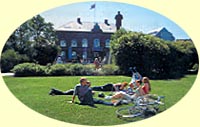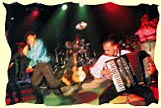Reykjavik's
compact size, however, belies its worldly status. It
is in every way a world capital, albeit a small
one. Here is where you'll find all of Iceland's national
glory, its theaters, night life, and much of its history.
In recent times, the city became prominent on the world
stage
when American President Ronald Reagan and Soviet General
Secretary Mikel Gorbachev met here in a summit that many
say marked the beginning of the end of the Cold War.
 Although
people have lived here since settler Ingolfur Arnarson
first arrived in the late 9th century and named the site “smoky
bay” after noticing some geothermal fog nearby, the
old homesteads are long gone, having been made of perishable
earth, wood, and grass. To get a good idea of the lay of
the
land, a perfect first stop is Hallgrimskirkja, the
towering church that stands above the famous statue of
explorer Leif Eiriksson. Climb the tower on a clear day,
and you can see for hundreds of miles, a phenomenon caused
by
the amazingly clear Arctic air.
Although
people have lived here since settler Ingolfur Arnarson
first arrived in the late 9th century and named the site “smoky
bay” after noticing some geothermal fog nearby, the
old homesteads are long gone, having been made of perishable
earth, wood, and grass. To get a good idea of the lay of
the
land, a perfect first stop is Hallgrimskirkja, the
towering church that stands above the famous statue of
explorer Leif Eiriksson. Climb the tower on a clear day,
and you can see for hundreds of miles, a phenomenon caused
by
the amazingly clear Arctic air.
Most of what has been preserved of Old Reykjavik lies
along Adalstraeti (“main street”), which
was once the site of a short-lived 18th century crafts
village. Other
notable older structures nearby are the Government House,
the National Gallery, and the Althing
(parliament house), which was relocated from Thingvellir in
1798. Those interested in Viking and Icelandic history will
want to visit the National Museum, where virtually
all of the country’s archeologic treasures are stored,
among them an elaborate 13th century door. More modern
structures include “the Pearl” (a revolving
restaurant build atop massive hot water tanks) and the
new Town
Hall. As far as modern art goes, there is the Kjarvalsstadir
Municipal Gallery and the Asmundur Sveinsson
Sculpture Gallery, with its outdoor garden filled with
giant, Piccasso-like sculptures.
 The
one thing most people have heard about Reykjavik is that
it has a wild night life, which is absolutely true. On
Friday
nights, downtown is packed with carousing teens and adults,
many of them happily swilling beer and klarvin, the local
vodka. This party-hearty tradition is known as the runtur,
or “circuit,” and this is the best time to head out and meet
Icelanders, who will probably be more than happy to show you
around the local restaurants, discos, and pubs. By the end of
the night, don’t be surprised if you are singing Icelandic
songs and introducing yourself by your Icelandic surname,
which you create by taking yours father’s first name and
adding either “son” or “dottir,” depending
on your sex.
The
one thing most people have heard about Reykjavik is that
it has a wild night life, which is absolutely true. On
Friday
nights, downtown is packed with carousing teens and adults,
many of them happily swilling beer and klarvin, the local
vodka. This party-hearty tradition is known as the runtur,
or “circuit,” and this is the best time to head out and meet
Icelanders, who will probably be more than happy to show you
around the local restaurants, discos, and pubs. By the end of
the night, don’t be surprised if you are singing Icelandic
songs and introducing yourself by your Icelandic surname,
which you create by taking yours father’s first name and
adding either “son” or “dottir,” depending
on your sex.
Reykjavik | Blue
Lagoon | Geysir | Gullfoss
| Akuryeri | Thingvellir
| Snaefellsnes Peninsula | Lake
Myvatn | Westmann Isles